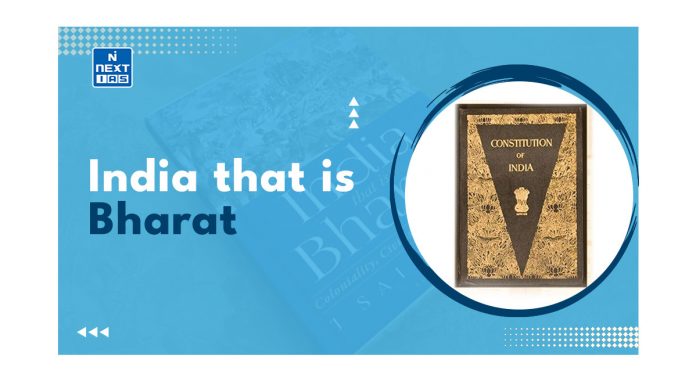This article covers “Daily Current Affairs” and the topic details “India that is Bharat: A perspective ”. This topic has relevance in the “Polity” section of the UPSC CSE exam.
Why in the News?
Recently, the incumbent administration led by Prime Minister Narendra Modi had chosen to use the term “President of Bharat” rather than “President of India” on an invitation card for the recent G-20 Summit. This alteration in terminology has garnered attention and implied a potential political significance behind the selection of these appellations.
Political Significance of this Move
After the opposition formed the INDIA alliance at Rahul Gandhi’s suggestion, there have been rumors of the government considering a name change for the country.
Other names for India
The ancient texts of Brahmanism, Buddhism, and Jainism unveil the existence of various names for our country, including Aryavarta, Bharatvarsha, and Jambudvipa.
Status of “India that is Bharat” in the Constitution
- Article 1: According to Article 1 of the Constitution, India that is Bharat, shall be a Union of States.
- Preamble: The Preamble states that “WE, THE PEOPLE OF INDIA, having solemnly resolved to constitute India into the SOVEREIGN DEMOCRATIC REPUBLIC and to secure to all its citizens.”
Origin of the Word India
- River Indus: The word “India” originally comes from Greek and Roman languages. The name “India” originates from the word “Indus,” which is the name of a river that runs through the northwestern region of the subcontinent.
- Megasthenes: A Greek traveler named Megasthenes used it around 350-295 BC when he wrote a book called “Indica.”
- Use by European travelers: Later on, the word “Indica” was changed to “India” in Roman language. Many European travelers who came to India also said it was a very rich and abundant land, just like Megasthenes had described.
Origin of the Word “Bharat”
- Linkages with Indian Scriptures: According to the Vishnu Purana, “Bharata” is described as the region situated between the southern ocean and the snow-covered Himalayan mountains in the north.
- Linkages with King Bharata: The word “Bharat” is derived from ancient Sanskrit and has its origins in Hindu mythology and history. It is associated with King Bharata, a legendary monarch mentioned in various Hindu scriptures, including the Mahabharata and the Puranas.
Debates in the Constitutional Assembly
The issue of the name of the newly independent country was a topic of discussion and debate among the members of the constitution makers. There was a divisive opinion about whether to go with India or go with Bharat. The proponents of Bharat associated with past glory, while the proponents of India wanted to continue with the same name to bring continuity and consistency.
The initial draft of the constitution presented by Dr. BR Ambedkar, who chaired the Drafting Committee on November 4, 1948, did not contain the term “Bharat”. On September 17, 1949, Ambedkar advocated changing Article 1 to read “India that is Bharat, shall be a Union of States” in the Constituent Assembly.
Members of the Constitutional Assembly Who had their Viewpoints on the Name Change
- HV Kamath: HV Kamath, who led the All India Forward Bloc, suggested the inaugural amendment to replace “Bharat, or in the English language, India.”
- Seth Govind Das: He recommended the utilization of “Bharat, known as India, also in foreign countries.”
- Kamalapati Tripathi: He suggested using “Bharat, that is, India.”
- Govind Ballabh Pant: Govind Ballabh Pant proposed simply “Bharat Varsha”.
Nevertheless, the Constituent Assembly rejected all other proposals and opted to adopt “India that is Bharat,” as originally suggested by Ambedkar.
Implications if the Name of the Country is Changed to India
- Exclusiveness to one religion: The word Bharat, taken from the Hindu scriptures, would have given the wrong signal to religious minorities. The country was already suffering from communal divisions, and such a move would have further aggravated the situation.
- Sensitive issue: The name of a country is closely tied to its national identity and pride, and making such a move overnight will invite mixed reactions from the people.
- International Recognition: A name change could potentially affect how other countries and international organizations recognise and interact with India. It might require diplomatic efforts to ensure a smooth transition in terms of treaties, agreements, and international relations.
- Administrative and Legal Adjustments: Changing the name would involve significant administrative and legal adjustments. Official documents, laws, currency, and government institutions would need to be updated.
- Economic Costs: Implementing a name change can be costly, including updating signage, currency, passports, and other official documents. It would be important to carefully weigh these expenses.
- Linguistic and Regional Considerations: India is a diverse country with many languages and regions. A name change might raise linguistic and regional considerations, as different languages and regions may have different names for the country.
Recent International Examples When the Name of the Country Changed
- Turkey to Türkiye: In 2022, Turkey changed its name to Türkiye, as the name signifies the best representation and expression of the Turkish people’s culture, civilization, and values.
- Zaire to the Democratic Republic of the Congo (1997): Zaire was renamed the Democratic Republic of the Congo in 1997 in an effort to dissociate itself from the dictatorial regime of Mobutu Sese Seko, who ruled for more than three decades.
Way Forward
The national consciousness and sense of belonging for a name develop over a period of time, and any sudden and non consensual decision might get a backlash. The aspects of the foreign origin of the word India must be carefully studied before taking a decision.
In a nutshell, changing the name of a country would ideally involve a broad consensus and acceptance among the population. There is a need to consider public opinion and sentiments among the people before taking any decision.
Sources:









